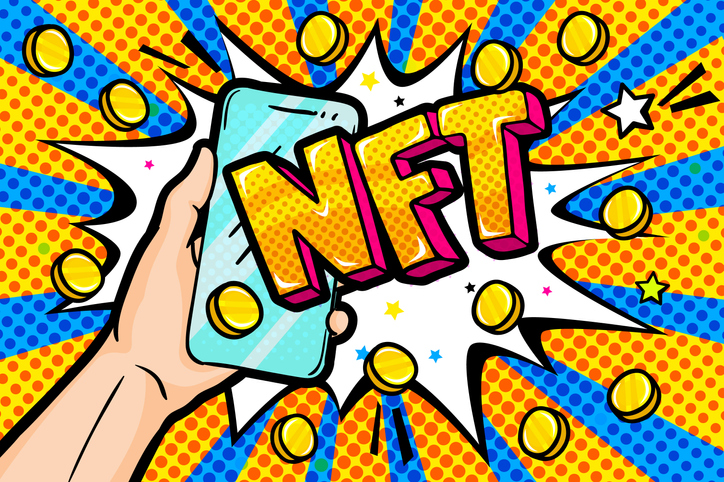Crypto, NFTs and Tungsten Cubes: Giving Cash In 2021
Nonfungible tokens and digital money are an alternative for the adventurous gift giver.
Cash in little wrapped boxes or tucked inside Hallmark cards is one of the most reliable and beloved gifts. But this holiday season, cash gifts are taking a new form as cryptocurrencies and nonfungible tokens, or NFTs.
Giving digital money requires planning, though, as you can’t simply buy one of these assets and send someone a link. Instead, they need someone to have a digital wallet already created, through a provider such as Rainbow, MetaMask or Coinbase. The wallet then holds the assets, effectively acting as a bank account.
“There’s a fixed cost to getting started, and there’s no way around that,” said Lex Sokolin, head economist and global fintech co-head at ConsenSys, a blockchain software technology company. “It is like you’re showing up to your friend’s house in 2002 and giving them an MP3 player and saying, ‘Here’s an MP3 player, now go throw out all your CDs.’”
Hassles aside, many parents, children and even friends are embracing these new products—at least for the more digital-savvy in their lives. Just as stock certificates and savings bonds were gifts with a purpose in years past, gifts of crypto or NFT art can teach the recipient about financial independence, investing and saving.
“Giving money is also giving an education,” said Shari Greco Reiches, wealth manager and co-founder of Rappaport Reiches Capital Management.
With that spirit in mind, here are some of the most 2021 ways to give money—not a gift card in sight.
Crypto starter packs
One easy way to help someone dip a toe into the world of digital currency is giving them a makeshift crypto starter pack.
Alex Salnikov, co-founder and head of product of NFT marketplace Rarible, said he has set up wallets for friends with the promise of then giving them an NFT on the other side. He also recommends products such as Linkdrop, which allow the giver to send onboarding links to begin setting up their own wallets.
Coinbase offers an option to share crypto assets with those not yet set up on their network, along with a message and a “fun little welcome,” said John Zettler, senior product manager at Coinbase. Setting up a wallet on Coinbase is free.
“These are effectively the keys to the community, and with it you make the person a part of said community,” Mr. Salnikov said.
Currency
If someone has already set up their own crypto wallet, Mr. Salnikov recommends giving them the coin or cryptocurrency most useful for their preferred activities, just as you might choose a gift card for their favorite store, rather than a generic Visa gift card.
Unlike setting up the wallet—free on many platforms—these coins don’t run cheap. Bitcoin rose in price from $30,000 at the end of 2020 to nearly $70,000 in 2021. Ethereum, another popular coin, is less expensive at close to $4,300. You can purchase portions of cryptocurrency, however, and every bitcoin is divisible, which means you can buy a slice of one at almost any amount you would like.
Memecoins, or a cryptocurrency related to an Internet joke, such as dogecoin, won’t set you back as much. (At its peak, dogecoin reached 75 cents in May 2021.) Sending these is “really like the financial equivalent of sending a funny cat picture,” Mr. Sokolin said.
NFTs
NFTs are best described as vouchers of authenticity for digital assets, be it art or music or anything else. They have surged in popularity this year, only a few years after they were first created in 2017. Marketplaces such as Rarible, Open Sea and Nifty Gateway can offer multiple ideas for NFT gifts, such as an animated rainbow cat illustration for 0.6 Ethereum and a GIF of dancing Taco Bell tacos for 4 Ethereum.
“It’s a unique digital 1-1 item that only you can own, and that can represent so many different things. So it comes down to: What does the recipient of the gift like?” Mr. Zettler said.
Depending on the desirability and availability of the given item, NFTs can also rise in value. NBA Top Shot allows users to purchase key moments in basketball history; legendary auction house Christie’s now offers original works of art to be purchased as NFTs; and bands such as Kings of Leon are releasing albums as NFTs.
Keep an eye on the price tag: These original collectibles can cost anywhere from a single dollar to the multimillions.
Financial products for children
Setting up a custodial investment account for a child can introduce them to investing, said Jordan Wexler, co-founder and chief executive of gifting platform EarlyBird.
Many brokerages and firms offer this option. Mr. Wexler’s product allows parents, grandparents or other adult gift givers to set up custodial investment accounts for children from birth, complete with video messages for particular celebrations, such as holidays and birthdays.
“There’s such an interesting movement in people not wanting waste anymore and leaning heavily into, ‘How can you charge something emotionally, more than a toy you give?’ ” Mr. Wexler said.
Givers can give anywhere from $15 to $2,500 at a frequency of their choice, doing so as either a recurring or one-time deposit.
Ms. Reiches has a more traditional recommendation: Give money to a 529 plan, which allows parents, grandparents and other adults to invest money that can be used for a beneficiary’s qualified education expenses.
Memestocks
Memestocks surged at the start of this year. Then they fell. Then they rose again. Amid it all, GameStop, AMC and other tickers have become household names.
Giving a share of these stocks is one option to bet on memestocks. You can also purchase a fractional share, Ms. Reiches said. Showing your recipient how to track the progress of their investment can be its own experience.
“Talk to the child about what companies they like and what companies they’re following,” she said. “It can teach discipline, long-term thinking and delayed gratification.”
Tungsten cubes
The Tungsten cube holds special appeal for people who want to take the intangible—the world of cryptocurrency, NFTs and decentralised finance—and make it tangible. These crypto enthusiasts do so with small grey cubes of the metal tungsten, a substance nearly twice as dense as lead. The cubes run anywhere from US$400 for a 2-inch cube to US$3,000 for a 4-inch cube.
Nic Carter, one of the original champions of the cube, said he has previously given them to family and friends for the holidays. But for those out of the joke, the gift may not resonate the way you hope.
“I’d only recommend that as a gift of someone who’s very, very into crypto and on crypto Twitter. Otherwise they’re going to stare at you with a blank face like, ‘What is that?’ ” Mr. Zettler said.
 Copyright 2020, Dow Jones & Company, Inc. All Rights Reserved Worldwide. LEARN MORE
Copyright 2020, Dow Jones & Company, Inc. All Rights Reserved Worldwide. LEARN MORE
This stylish family home combines a classic palette and finishes with a flexible floorplan
Just 55 minutes from Sydney, make this your creative getaway located in the majestic Hawkesbury region.
Continued stagflation and cost of living pressures are causing couples to think twice about starting a family, new data has revealed, with long term impacts expected
Australia is in the midst of a ‘baby recession’ with preliminary estimates showing the number of births in 2023 fell by more than four percent to the lowest level since 2006, according to KPMG. The consultancy firm says this reflects the impact of cost-of-living pressures on the feasibility of younger Australians starting a family.
KPMG estimates that 289,100 babies were born in 2023. This compares to 300,684 babies in 2022 and 309,996 in 2021, according to the Australian Bureau of Statistics (ABS). KPMG urban economist Terry Rawnsley said weak economic growth often leads to a reduced number of births. In 2023, ABS data shows gross domestic product (GDP) fell to 1.5 percent. Despite the population growing by 2.5 percent in 2023, GDP on a per capita basis went into negative territory, down one percent over the 12 months.
“Birth rates provide insight into long-term population growth as well as the current confidence of Australian families,” said Mr Rawnsley. “We haven’t seen such a sharp drop in births in Australia since the period of economic stagflation in the 1970s, which coincided with the initial widespread adoption of the contraceptive pill.”
Mr Rawnsley said many Australian couples delayed starting a family while the pandemic played out in 2020. The number of births fell from 305,832 in 2019 to 294,369 in 2020. Then in 2021, strong employment and vast amounts of stimulus money, along with high household savings due to lockdowns, gave couples better financial means to have a baby. This led to a rebound in births.
However, the re-opening of the global economy in 2022 led to soaring inflation. By the start of 2023, the Australian consumer price index (CPI) had risen to its highest level since 1990 at 7.8 percent per annum. By that stage, the Reserve Bank had already commenced an aggressive rate-hiking strategy to fight inflation and had raised the cash rate every month between May and December 2022.
Five more rate hikes during 2023 put further pressure on couples with mortgages and put the brakes on family formation. “This combination of the pandemic and rapid economic changes explains the spike and subsequent sharp decline in birth rates we have observed over the past four years,” Mr Rawnsley said.
The impact of high costs of living on couples’ decision to have a baby is highlighted in births data for the capital cities. KPMG estimates there were 60,860 births in Sydney in 2023, down 8.6 percent from 2019. There were 56,270 births in Melbourne, down 7.3 percent. In Perth, there were 25,020 births, down 6 percent, while in Brisbane there were 30,250 births, down 4.3 percent. Canberra was the only capital city where there was no fall in the number of births in 2023 compared to 2019.
“CPI growth in Canberra has been slightly subdued compared to that in other major cities, and the economic outlook has remained strong,” Mr Rawnsley said. “This means families have not been hurting as much as those in other capital cities, and in turn, we’ve seen a stabilisation of births in the ACT.”
This stylish family home combines a classic palette and finishes with a flexible floorplan
Just 55 minutes from Sydney, make this your creative getaway located in the majestic Hawkesbury region.






















